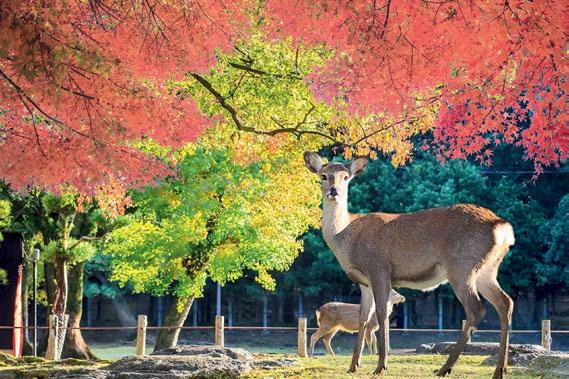
1 minute read
nara
Where history meets modernism
WORDS Khursheed Mistry
Advertisement
Originally known as Yamato, Nara was Japan’s first capital and the seat of the Emperor. Rich in ideas and technology from Europe, China and Korea via the Silk Road, Nara is a living museum with 1,300 years of art and architecture to offer. Japan’s capital Heijokyo before Kyoto, with a palace and administrative buildings, was established near what is now Nara city. Based on the Chinese city of Xi’an, the city was built in a grid format with the Palace at its north end.
Emperor Shomu directed the works of Tōdai-ji Temple and the world’s largest bronze Buddha, as a way to bring hope after wars, a smallpox outbreak and the failure of crops. After the capital was moved to Kyoto, Heijokyo was abandoned and very little remained beyond the foundations. Several buildings and the south gate have since been restored and walking around the palace grounds gives visitors an idea of the magnificent grandeur of the ancient capital.
Nara contains the lion's share of the oldest national treasures; in sculpture, 35 national treasures are from before the eighth century. In buildings, 32 of Nara's national treasures date from the 12th century.
Two of the greatest masterpieces of 8th-century Japanese literature originate in Nara. The Kojiki is a collection of the legends of the Gods and how Japan was founded. It shows Nara as the scene of many important historic events and epic dramas. The Manyoshu, which is the oldest collection of Japanese poetry, is the bible of Japanese letters. Artworks inspired by the poems are displayed at the Nara Prefecture Complex of Man'yo Culture. Nara has a range of Buddhist artwork spanning centuries and the carvings and sculptures, vary significantly in style and appearance. The shrines and temples of Nara are art galleries exhibiting much of the country's finest Buddhist art.
Explore Japan’s history, arts and culture in Nara, home to three World Heritage sites; historic monuments of ancient Nara, Buddhist monuments, sacred sites and pilgrimage routes in the Kii mountain range. With a plethora of activities to keep one enthralled, natural scenic beauty, charming townscapes, national treasures, delectable culinary experiences, events and luxury hotels - the idyllic Nara city which is less than an hour by train from Kyoto and Osaka, and easily accessible from Tokyo is a must visit.










